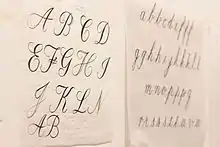Lettering
Lettering is an umbrella term that covers the art of drawing letters, instead of simply writing them. Lettering is considered an art form, where each letter in a phrase or quote acts as an illustration. Each letter is created with attention to detail and has a unique role within a composition.[1] Lettering is created as an image, with letters that are meant to be used in a unique configuration. Lettering words do not always translate into alphabets that can later be used in a typeface, since they are created with a specific word in mind.[2]
.jpg.webp)
Examples

Lettering includes that used for purposes of blueprints and comic books, as well as decorative lettering such as sign painting and custom graphics. For instance; on posters, for a letterhead or business wordmark, lettering in stone, lettering for advertisements, tire lettering, fileteado, graffiti,[3] or on chalkboards.[4]
Lettering may be drawn, incised, applied using stencils,[5][6][7] using a digital medium with a stylus, or a vector program. Lettering that was not created using digital tools is commonly referred to as hand-lettering.[1]

In the past, almost all decorative lettering other than that on paper was created as custom or hand-painted lettering. The use of fonts in place of lettering has increased due to new printing methods, phototypesetting, and digital typesetting, which allow fonts to be printed at any desired size.[8][9][10][11] Lettering has been particularly important in Islamic art, due to the Islamic practice of avoiding depictions of sentient beings generally and of Muhammad in particular, and instead using representations in the form of Islamic calligraphy, including hilyes, or artforms based on written descriptions of Muhammed.
More recently, there has been an influx of aspiring artists attempting hand-lettering with brush pens and digital mediums. Some popular styles are sans serif, serif, cursive/script, vintage, blackletter ("gothic") calligraphy, graffiti, and creative lettering.[12]
Related artforms
Calligraphy is based on penmanship; it’s essentially "writing letters." Lettering, on the other hand, is based on draftsmanship, i.e. "drawing letters."
— Joseph Alessio[13]
Lettering can be confused with similar terms, such as calligraphy or typography.
Calligraphy is known as a more rigid process, that requires learning the formal shapes of letters and often combining thick downstrokes with thin upstrokes. This style of writing is generally created with dip pens and inks. Some calligraphers and hand-letterers say that calligraphy created with brush pens becomes lettering or faux-calligraphy,[14] but others believe that the approach used to create the letters is more important than the tools used to do so.[1][15]
Typography is referred to as the use of type in a repeating system, where each instance of the same letter looks the same.[1] [15]
Part of the reason why these misconceptions are common is that some font shops categorize their fonts as "hand-lettered", "illustrated" or "calligraphy". Said fonts can begin with a hand-lettered alphabet that is then digitized and turned into a repeatable system. This identifies them as typography, instead of lettering.[1]
Hand Lettering for Beginners defines the three terms as follows: Lettering is the art of drawing letters, calligraphy is the art of writing letters, and typography is the art of using letters.[1]
See also
- Typeface anatomy, the graphic elements that make up letters in a typeface
References
- "Hand-lettering, Calligraphy, Typography: What's the Difference?". Hand Lettering for Beginners. Archived from the original on 27 April 2021. Retrieved 29 February 2020.,
- "FAQ". Jessica Hische. Retrieved 29 February 2020.,
- Callingham, James (1871). Sign Writing and Glass Embossing.
- Foster, Walter (2014). Creative Lettering and Beyond. Quarto Publishing Group USA.
- Pool, Albert-Jan. "FF DIN: Digital Block Letters" (PDF). FontShop. Archived from the original (PDF) on 30 March 2017. Retrieved 14 December 2016.
- Mosley, James. "Lettres à jour: public stencil lettering in France". Type Foundry (blog). Retrieved 12 December 2015.
- MacMillan, David. "Why No "Type Designers" Here?". Circuitous Root. Retrieved 2 July 2022.
- Simonson, Mark. "Not a font". Mark Simonson Studio (blog). Retrieved 14 December 2016.
- Coles, Stephen. "Lettering is not type". Type Network. Archived from the original on 2021-04-27. Retrieved 2019-07-25.
- Johnston, Alastair. "The Misery of Edwin Drood". Booktryst. Retrieved 14 December 2016.
- Shinn, Nick. "The Golden Age of Hand Lettering in American Advertising". Type Culture. Retrieved 1 April 2017.
- "What Are The Different Lettering Styles?". Lettering Daily. 2018-09-24. Retrieved 2019-06-25.
- Joseph Alessio (January 17, 2013). "Understanding The Difference Between Type And Lettering". Smashing Magazine. Retrieved 8 May 2021.
- "The Difference Between Hand Lettering, Calligraphy and Typography (+ Why It Truly Matters)". Letter Lane Design Studio. 22 March 2016. Retrieved 29 February 2020.,
- "What is the Difference Between Hand Lettering and Calligraphy". Lettering Daily. 3 October 2018. Retrieved 29 February 2020.,
External links
Many textbooks on lettering or books of example alphabets were published in the nineteenth and early twentieth centuries. Those linked below are free to read at archive.org.
- A Textbook on Lettering and Sign Painting. Scranton, PA: International Correspondence Schools. 1902. OCLC 1085618630.
- Armstrong, George D.; Hodgson, Frederick Thomas; Delamotte, Frances George (1914). Modern painting, hardwood finishing and sign writing. Sears, Roebuck. OCLC 1049637942.
- Johnston, Edward (1917). W. R. Lethaby (ed.). Writing & Illuminating & Lettering. The Artistic Crafts Series of Technical Handbooks. London, England: John Hogg. OCLC 1158486814.
- Muster-Alphabete : verschiedener Schriftarten in den neuesten Formen (in German). 1880. OCLC 1049698520. (sampler)